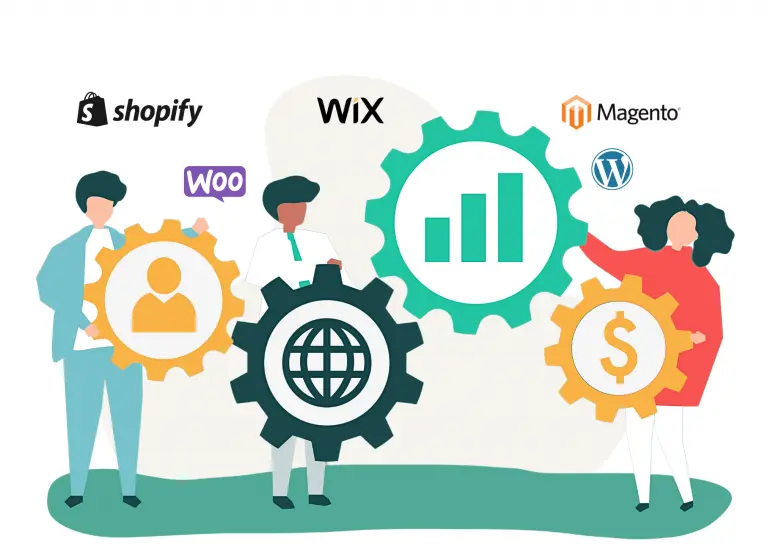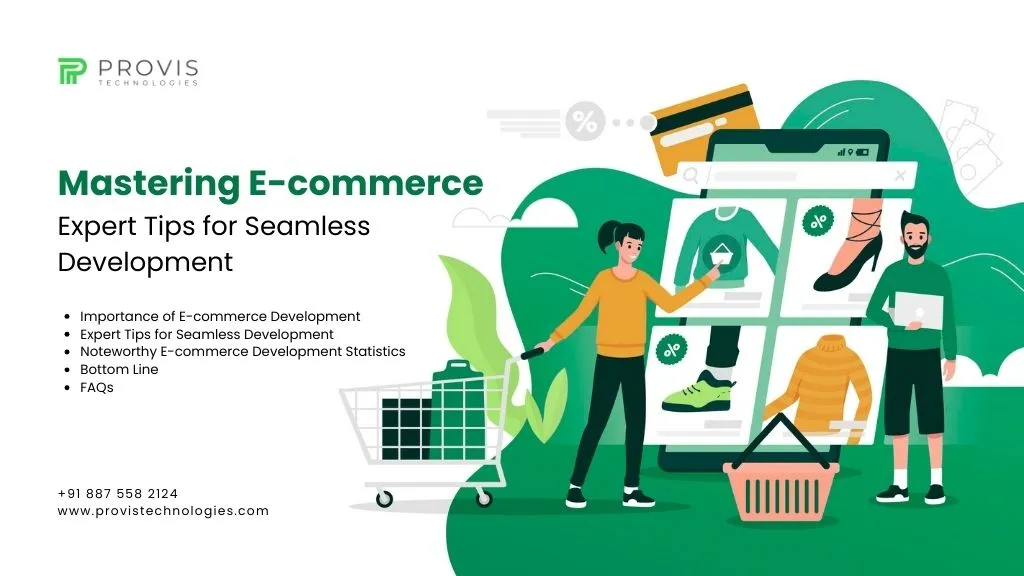E-commerce development is a sophisticated process that involves creating and maintaining online stores where businesses can sell products or services to customers over the Internet. It encompasses various elements, including website design, functionality, security, and marketing strategies. Successful e-commerce development requires a deep understanding of consumer behavior, market trends, and technological advancements to create a smooth online shopping experience. Before we move on to understand the top tips for seamless e-commerce development, let’s know its importance.
Importance of Seamless E-commerce Development
Smooth e-commerce development is crucial for the success of an online store as it directly impacts user experience, conversion rates, and overall business performance. A flawless website ensures visitors can easily navigate, find products, and complete purchases without encountering obstacles. By prioritizing e-store making, businesses can enhance customer satisfaction, build trust, and drive repeat purchases – leading to increased revenue and long-term success.
Read More: Color Palette Generators for Website
Key Points
- Seamless development enhances user experience and boosts conversion rates.
- It fosters trust & loyalty among customers, leading to increased sales & revenue.
- Prioritizing seamless online store development is essential for staying competitive in the crowded e-commerce market.
Expert Tips for Seamless Development
1. Planning Your Ecommerce Project

Before embarking on seamless e-commerce development, it’s a must to have a plan. This involves defining your target audience, setting clear goals and objectives, determining your budget, and outlining the features and functionalities you want to include in your online store. A well-thought-out plan serves as a roadmap for your e-commerce project, guiding decisions and ensuring that your website meets the needs and expectations of your target audience.
Read More: Why is 2024 a Great Year to Start Your E-commerce?
Key Points
- Planning your e-commerce project helps clarify objectives and allocate resources effectively.
- It ensures your website aligns with your business goals and target audience preferences.
- A comprehensive plan reduces the risk of costly delays and revisions during development.
2. Choosing the Right E-commerce Platform

Selecting the right e-commerce platform is a critical decision that can significantly impact your website’s performance & scalability. When choosing an e-commerce platform, consider factors such as ease of use, customization options, integrations, pricing, and support. Popular e-commerce platforms like WooCommerce, Wix, Shopify, and Magento offer a range of features and functionalities to suit different business needs & budgets.
Must Read: The Future of E-commerce: Embracing SaaS Solutions
Key Points
- The right ecommerce platform provides a solid foundation for your online store’s success.
- Consider scalability, flexibility, and support when choosing a platform.
- Evaluate different platforms based on your specific requirements & budget constraints.
3. Designing Your Ecommerce Website

The e-commerce website design helps in drawing & retaining consumers. A visually appealing layout, intuitive navigation, clear product categories, high-quality product images, and compelling calls to action can enhance the user experience & drive conversions. Collaborate with experienced e-commerce developers like Provis Technologies to create a website that reflects your brand identity and engages visitors from the moment they land on your site.
Read More: 10 Essential Tips for Launching Your E-commerce Journey with WooCommerce
Key Points
- A well-designed e-commerce website captivates visitors and encourages exploration.
- Focus on creating a user-friendly interface and slick navigation to simplify the shopping experience.
- Invest in professional design services to ensure your e-commerce website stands out and resonates with your target audience.
4. Optimizing User Experience (UX)

Optimizing the UX ensures visitors have a positive experience with your e-commerce website. This involves improving page load times, simplifying the checkout process, providing detailed product descriptions and reviews, and offering responsive customer support. Conduct user testing and gather feedback to identify pain points and areas for improvement, then implement changes to enhance the overall user experience.
Read More: A Step-by-Step Guide to Website Optimization Strategies for 2024
Key Points
- User experience optimization enhances customer satisfaction and encourages repeat purchases.
- Prioritize speed, usability, and accessibility to create a frictionless shopping experience.
- Continuously monitor user behavior and feedback to identify opportunities for optimization.
5. Implementing Secure Payment Systems

Security must be top-notch seamless e-commerce development, especially when handling sensitive customer information and processing online payments. Implement robust SSL encryption, PCI compliance, and fraud detection systems – to safeguard customer data and build trust with your audience. Partner with reputable payment gateways to ensure secure transactions and protect against cyber threats.
Read More: Mastering E-commerce Expert Tips for Seamless Development
Key Points
- Secure payment systems instill confidence in customers and reduce the risk of data breaches.
- Prioritize security compliance and encryption to protect sensitive information during transactions.
- Partner with trusted payment providers to secure payment processing for your customers.
6. Integrating Inventory Management
Efficient inventory management ensures e-commerce stores can effectively track and manage product inventory, orders, and stock levels. Integrate an inventory management system that allows real-time updates, automated reordering, and instant synchronization across multiple sales channels. Maintaining accurate inventory records can prevent stockouts, avoid overselling, and improve operational efficiency.
Read More: WooCommerce Solutions for Thriving Online Stores
Key Points
- Streamlined inventory management minimizes errors and ensures product availability.
- Integrate inventory systems with your e-commerce platform for fast order fulfillment and tracking.
- Leverage inventory data to optimize purchasing decisions and forecast future demand accurately.
7. Leveraging Digital Marketing Strategies
Digital marketing is crucial in driving traffic & sales to your e-commerce website. Implement a comprehensive digital marketing strategy that includes search engine optimization, PPC advertising, SMM, email marketing, and content marketing to attract and engage your target audience. Tailor your marketing efforts to reach customers at every stage of the buying journey and encourage conversions through targeted messaging and personalized experiences.
Must Read: The Future of E-commerce: Embracing SaaS Solutions
Key Points
- Digital marketing drives visibility, traffic, and conversions for your e-commerce store.
- Utilize a mix of channels and tactics to reach your target audience and maximize ROI.
- Continuously monitor campaign performance and adjust strategies based on data insights to optimize results.
7. Testing & Quality Assurance
Thorough testing & quality assurance are essential steps in e-commerce development to identify and resolve any issues or bugs before launching your website. Conduct usability, performance, security, and compatibility tests across different devices & browsers for user experience. Involve stakeholders and gather feedback throughout the testing process to address concerns and make necessary improvements before going live.
Read More: Dive into Multi-vendor Marketplaces: Your Path to E-commerce Dominance
Key Points
- Testing ensures your e-commerce website functions as intended and meets user expectations.
- Conduct comprehensive tests to identify and address any issues or inconsistencies before launch.
- Prioritize quality assurance to deliver a polished and error-free experience for your customers.
8. Launching Your Ecommerce Website
Once your e-commerce website is developed and thoroughly tested, it’s time to launch it. Plan a successful launch strategy that includes promotional activities, email campaigns, social media announcements, and press releases to generate excitement and drive traffic to your website. Monitor website performance closely during the launch phase and address issues or concerns to ensure a smooth rollout.
Read More: From Concept to Launch: Building Single Vendor E-commerce Experiences
Key Points
- A successful website launch generates buzz and drives traffic to your e-commerce store.
- Coordinate marketing efforts to create anticipation and attract visitors to your website.
- Monitor website performance and user feedback after launch to identify any areas for improvement.
9. Continuous Monitoring & Improvement
E-commerce development is an ongoing process that requires continuous monitoring & improvement to stay competitive and meet the evolving customer needs. Monitor key performance metrics, gather feedback, and implement updates to optimize your website’s performance over time. Stay informed about industry trends and technological advancements to stay ahead of the curve and maintain a competitive edge in the market.
Must Read About: Seizing the Market: Strategies for E-commerce Growth & Expansion
Key Points
- Continuous monitoring is essential for maintaining a high-performing e-commerce website.
- Regularly analyze data & user feedback to identify opportunities for optimization.
- Stay proactive in addressing issues and adapting to changes to ensure long-term success.
10. Scaling Your E-commerce Business
As your e-commerce business grows, scalability becomes increasingly important to accommodate higher traffic volumes, increased sales, and expanding product catalogs. Invest in scalable infrastructure, flexible e-commerce platforms, and streamlined processes to support the growth and success of your online store. Continuously evaluate and adjust your strategies to align with changing market dynamics and customer preferences to ensure the online business remains agile and resilient in the face of evolving challenges.
Key Points
- Scalability enables your e-commerce business to grow and adapt to changing demands & opportunities.
- Invest in scalable solutions and infrastructure to support increased traffic, sales, and product offerings.
- Stay agile and responsive to market trends & customer feedback to capitalize on growth opportunities and maintain a competitive edge.
Noteworthy E-commerce Development Statistics

E-commerce Sales Growth
E-commerce sales are projected to reach $6.38 trillion globally by 2024 – a steady increase from $3.53 trillion in 2019. (Source: Statista)
Must Read: AI in E-commerce Benefits of Artificial Intelligence in E-commerce
Impact of User Experience
A one-second delay in website loading time can result in a 7% reduction in conversions, highlighting the importance of optimizing user experience for e-commerce success. (Source: Akamai)
Bottom Line
Mastering e-commerce development requires careful planning, attention to detail, and a commitment to delivering an exceptional user experience. By following expert tips & best practices in seamless e-commerce development, you can create a seamless online shopping experience that attracts customers and fuels business growth. By prioritizing seamless development – you can build a successful e-commerce business that stands out in a competitive market landscape. If you wish to learn more about the best ways to develop an e-commerce platform, connect with top e-commerce development agencies like Provis Technologies.
FAQs
E-commerce development involves creating online stores where businesses can sell products or services to customers over the Internet.
Seamless development ensures a smooth user experience, leading to higher conversion rates and customer satisfaction.
Consider ease of use, customization options, integrations, pricing, and support when selecting an e-commerce platform. Provis Technologies is the leading e-commerce development agency – you can get their help.
Launching an e-commerce website involves planning a successful launch strategy, conducting thorough testing, and monitoring performance closely.
Optimize your e-commerce website for search engines by using relevant keywords, optimizing product descriptions and meta tags, and improving site speed and mobile-friendliness.
To scale your e-commerce business, invest in scalable infrastructure, flexible e-commerce platforms, and streamlined processes to support increased traffic and sales.
Written By
Author's Picks
- E-commerce Evolution: Trends & Technologies Shaping the Industry
- 22/04/2024
- Must-Know Tips for Achieving Better Android App Performance
- 29/12/2024
- Rational Agent In AI: Intelligent Agents in Artificial Intelligence
- 13/01/2025
Categories
- AI for Startups
- AI in Web Development
- AI Integration
- AI Platforms
- AI Prompt
- AI Tools
- AI Trading Software
- Android App
- Android vs iOS Development
- Angular
- API
- API Development
- App
- app development
- App Idea
- App User Feedback
- Application
- Artificial Intelligence
- Audit Services
- Automotive Industry
- Awards and Recognition
- Business Consulting
- Business Website
- Chatbots
- CRM
- CRM for Financial Advisors
- Custom CRM
- Custom SaaS
- Custom Website
- Customer Service
- dashboard design
- Developing a Mobile App
- Digital Business
- E-commerce
- EMR Integration
- Finance
- Financial Advisors
- Financial Advisors
- GIT
- Health Insurance
- iOS App
- iOS App Development
- IoT Mobile App Development
- IoT Platforms
- IT Audit Services
- IT Consulting
- IT Strategies
- Java Development
- Laravel
- Lean Canvas
- Learning Management System
- Logistics Apps
- Mobile App Development
- MVP
- Native App
- News Aggregator Site
- OTT
- Outsourcing IT
- Payment Gateway
- predictive analysis
- Product Launch Strategy
- Progressive Web App (PWA)
- Prototype
- Recommender Systems
- Ruby
- SaaS
- SaaS Application
- SaaS Business
- SaaS Company
- SaaS Development
- SaaS Product
- SaaS Project
- Sales Funnel
- SEO
- Shopping Cart
- Software Development
- SSL and TLS
- Startup Checklist
- Technology
- Tetradic Color Scheme
- UI/UX Design Company
- Unit Testing
- User Flow
- User Testing
- Web Development
- Web Performance Optimization
- website Maintenance Services
- Website Migration Service
- Website Speed Optimization
- WooCommerce
- WordPress





